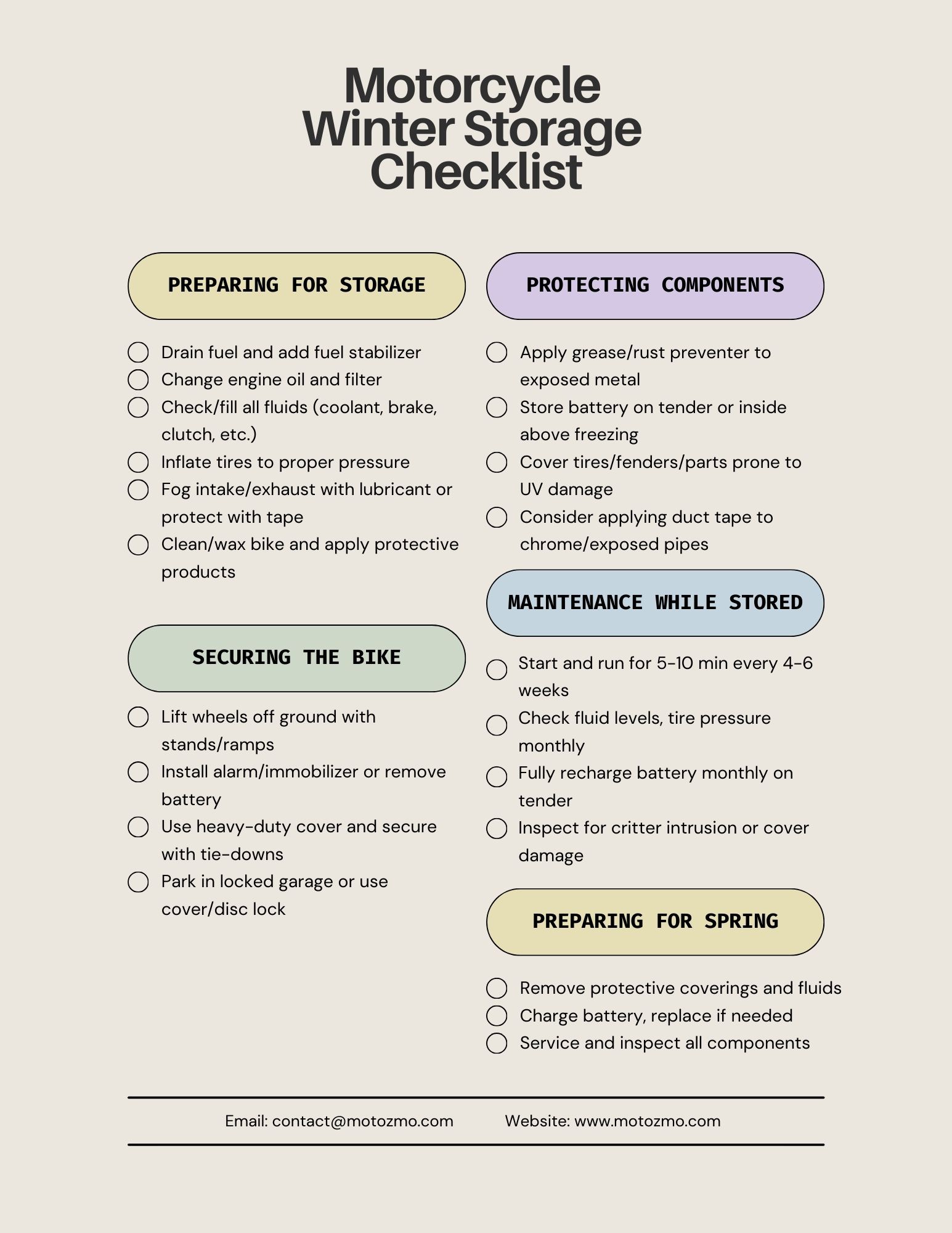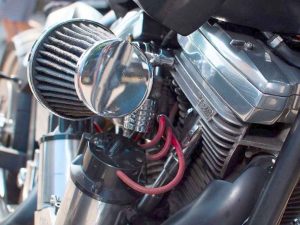As the leaves start to turn and nights get cooler, it’s about that time. Time to put our trusty steeds to bed for a long winter’s nap. But before throwing that cover on, we have make sure to thank them right for another season of fun.
Proper storage is key if we want our rides to start up again with a roar come spring. Because if we don’t prep them, the elements will have their way – corroding those engines, flattening tires, draining batteries. No one wants to discover those kinds of unhappy surprises after months of snow. But how to store motorcycle for winter?
We’ll run through the full checklist for winterizing like pros. From fluid fills to fueling up, covers to chargers, we’ve got all the bases covered.
KEY POINTS
- Change your fluids – Winter is a good time to swap out oil, coolant and brake fluid that has degraded over the season.
- Prep the fuel system – Add a fuel stabilizer and fill up the tank to prevent gumming over the cold months.
- Inspect and protect – Check tires, battery, chain/belts and plug exhausts/intakes. Apply wax or protectants.
- Choose safe storage – Select an indoor garage/basement if possible, otherwise find a dry, sheltered outdoor spot.
- Avoid common mistakes – Don’t start the bike unnecessarily, drain gas, or use low-quality covers that can damage your motorcycle over the winter.
How to Store Motorcycle for Winter: Winterizing Checklist
Before putting the bike into storage for winter, we need to do some maintenance tasks.
We’ll change fluids, lube the chain, and give the tires some air. Don’t forget fuel stabilizer! Then it’s off to the charger with the batteries. With proper winterizing, the bike will stay in good condition until we ride again next spring.
1. Change the Oil
Let’s go ahead and swap out that old oil. After being in the engine all summer, it’s probably pretty gunked up. No sense leaving it in there over the winter when it’ll be sitting for months.
2. Check all Fluids
While we’ve got everything open, we may as well check the coolant, brake fluid and clutch fluid too. Top off any that are low so you don’t have any leaks or issues when you fire it back up in the spring.
3. Inspect the Tires
Take a look at those tires and air them up to the proper PSI listed in your manual. Make sure the tread looks good with no bald or cracked spots. The last thing you want is a flat tire due to worn rubber when you take her out for a ride next season.
4. Give it a Clean
Once all the mechanical stuff is taken care of, it’s time to break out the bucket and rags. Give that paint a good wash to remove all the grime from the roads. Then polish it up nicely with a coat of wax to protect it under the cover for winter.
5. Lube Up That Chain
If your ride has a chain drive, you’ll want to give it some love before storing it away. Clean off any grit and gunk, then hit it with some fresh lubricant. This’ll keep it nice and protected under the cover.
I remember one winter I forgot to lube my chain. Big mistake! When I took the bike out in spring, the chain was rusted solid. Took me hours to get it moving again.
6. Check Any Belts
For you belt drive guys, just make a quick inspection. Look for any cracks or fraying. While you’ve got the manual out, confirm the proper tension spec too. Don’t want that belt slipping next season!
7. Plug It Up
Before covering ‘er up, stuff some plastic or a rag in the exhaust and air intakes. This’ll keep squirrels and other critters from shacking up in there over the winter. Trust me, you don’t want to pull back that cover and find a family of mice living under the seat!
8. On The Charger
Let’s not forget about our trusty steed’s battery. Pull it out and stick it on a trickle charger or tender. This’ll keep it happy and healthy all snuggled up inside where it’s warm. Last thing you want is a dead battery come spring thaw.

Fueling Up and Deciding on a Storage Spot
Now that our bikes are winterized, let’s talk fuel and where we’ll keep them.
Add Stabilizer and Fill the Tank
This one is super important. We all know what untreated gas does over a long winter – it gums up our systems something fierce.
To avoid that mess, add some fuel stabilizer to the fuel tank. Run the engine for a bit too so it circulates through the whole fuel line. You don’t want any parts drying out.
Indoor vs Outdoor Storage
Now comes the big question – garage or yard? Obviously an indoor spot is best, keeping your ride safe from the elements. But not all of us have that luxury. If storing outside is your only option, make sure to waterproof the electrics and find a covered, dry area. Maybe ask a buddy with a barn if you can stash it there.
Personally, I’m lucky to have a spot in my heated garage. Nothing beats pulling up to a cozy, rust-free ride after a long winter. Always make sure your storage spot has plenty of ventilation too, you don’t want moldy seats.
Shelter Your Ride
If outdoor storage is your only option, at least try to find a sheltered spot. Maybe you’ve got an enclosed carport or shed you can use. This will keep the rain, snow and sunshine off your paint and upholstery.
I’ve also seen folks use tarps suspended from sheds as a cheap alternative. Just be sure to secure everything tightly so it doesn’t blow away in a storm. The last thing you want is finding your pride and joy under a pile of wet canvas come spring!
Climate Controlled Storage
If you’re lucky enough to have access to a climate controlled storage unit, your bike will be living in 5-star conditions this winter. The steady temperature and humidity levels prevent corrosion better than any garage or barn.
Plus, no worries about pipes freezing like you get with outdoor exposure. And no dust or critters getting inside like sometimes happens even indoors. Coming back to your mint condition ride, instead of rust or a rat nest, is definitely worth the few extra bucks in my book. If you’ve got the means, climate control is the way to go.
Avoiding Common Winter Storage Mistakes
Now, we’ll go over some typical no-nos people make when storing the bike for the winter.
1. Don’t Start the Engine Periodically
I know it’s tempting to give your buddy a turn every now and then just to hear her purr. But unless you’re taking her out for a proper rip, it’s best just to let her rest. All you’ll end up with is puddles of moisture in awkward places.
Don’t Drain the Gas Tank
Another mistake is draining out that fuel. Modern gas is better than the stuff from years past, but it’ll still get gummy if left untreated. So don’t drain; just add some fuel stabilizer as we previously discussed. That stuff will keep your fuel line nice and fluid come spring.
Don’t Store a Dirty Bike
We talked about washing your bike earlier, but it bears repeating – don’t store a dirty ride. All that crud trapped underneath a cover will lead to surface rust and corrosion like you wouldn’t believe.
Trust me, I made this mistake once and learned the hard way. Spent all spring scrubbing rust spots off because I got lazy with the cleaning. Don’t be like me; clean that frame and finish with enthusiasm before covering up shop.
Never Use Cheap Covers or Tarps
While we’re on the subject, only use quality materials designed for long-term storage. Forgo things like tarps and trash bags that can puncture or allow moisture in.
I’ve seen tarps turned into shredded confetti more than once in winter storms. Opt for a breathable motorcycle cover made for the job instead. The few extra bucks is worth protecting your paint and plastics properly.
FAQs About How to Store Motorcycle for Winter
Can I start my motorcycle periodically over the winter?
It’s generally not recommended as it can cause moisture issues. However, a very brief start-up once a month is okay if you let the engine fully warm up first.
How often should I check my stored motorcycle?
Aim to take a quick look at least once a month if storing outdoors. Check for torn covers, critters nesting, and that it hasn’t been moved.
Should I charge the battery all winter?
A trickle charger or tender is best to keep it at a full charge without over-charging. Charge monthly if you can’t leave it on all season.
What’s the best way to clean the chain?
Use a degreaser, brush it clean and lubricate. Rinse thoroughly to remove old lube/grit before applying fresh lube for winter storage.
How do I protect the tires over winter?
Inflate to proper psi and consider tire covers made of an impermeable material like vinyl to protect against UV rays and weather cracking.

![You are currently viewing How to Store Motorcycle for Winter [and Mistakes to Avoid]](https://www.motozmo.com/wp-content/uploads/2023/11/winter-motorcycle-storage.jpg)


